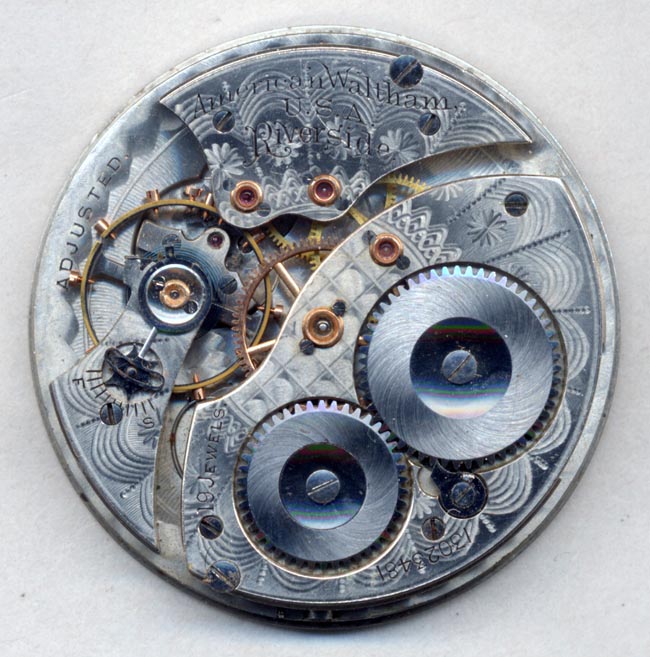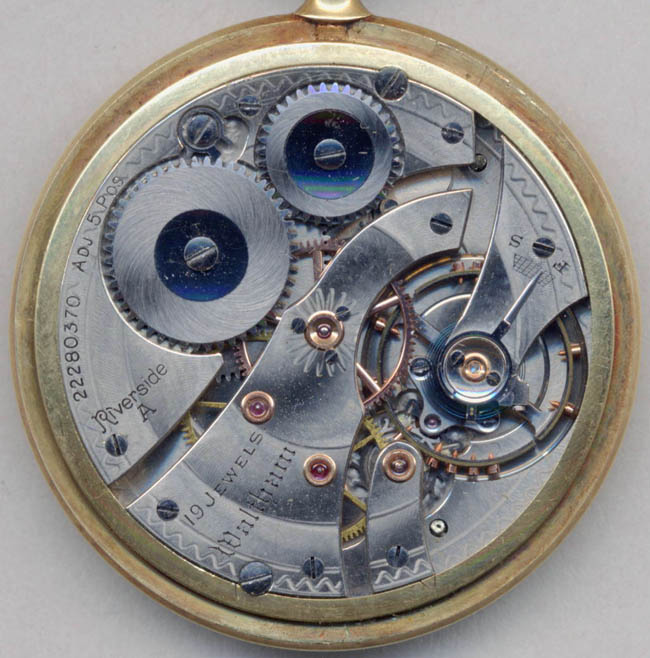
| WWT Shows | CLICK TO: Join and Support Internet Horology Club 185™ | IHC185™ Forums |

|
• Check Out Our... • • TWO Book Offer! • |
Welcome Aboard IHC185™  Internet Horology Club 185
Internet Horology Club 185  IHC185™ Discussion Site Main Page
IHC185™ Discussion Site Main Page  Our Exclusive "Timekeepers Photo Gallery"
Our Exclusive "Timekeepers Photo Gallery"  IHC185™ "Timekeepers Photo Gallery"
IHC185™ "Timekeepers Photo Gallery"  Waltham's Riverside Grade
Waltham's Riverside Grade
 Internet Horology Club 185
Internet Horology Club 185  IHC185™ Discussion Site Main Page
IHC185™ Discussion Site Main Page  Our Exclusive "Timekeepers Photo Gallery"
Our Exclusive "Timekeepers Photo Gallery"  IHC185™ "Timekeepers Photo Gallery"
IHC185™ "Timekeepers Photo Gallery"  Waltham's Riverside Grade
Waltham's Riverside GradeGo  | New Topic  | Find-Or-Search  | Notify  | Tools  | Reply to Post  |  |
And the 1899 model Riverside Maximus. This one is lever set and railroad approved (many are pendant set).  | ||||
This 23 jewel Maximus is one very nice looking watch Jerry!! | ||||
It is even better in hand. It is very difficult to capture the full beauty of the Riverside Maximus. When I post the 12-size you will see another nice example. | ||||
This image shows the second plate pattern used on the 1874 model 14-size Riverside (image also snagged from an eBay auction).  | ||||
Here is an 1884 model Riverside.  | ||||
Here is the 1895 model 14-size Riverside. This model is derived from the 1888-model 16 size movement.  | ||||
And here is the considerably thinner 1897 model 14-size (based on the 1894 model 12-size movement). ("borrowed" image replaced on 10/23/05 with one of my own).  | ||||
I have two more to round out the 14-size Riversides before we finish off with the 6, 8 and 12-size. This is the Colonial Series Riverside, with a 14-size dial and front plate (like the 1897 model above) but the back plates are standard 12-size. The hunters (scarce) used this 3/4-plate configuration whereas the open-face models mostly used the semi-bridge pattern.  | ||||
And the last 14-size is the Colonial-A, made only in Riverside or Maximus (not Riverside Maximus) grades. This example was up-jeweled at the factory from the original 19 jewels.  | ||||
Hi Jerry, Would you consider this chronograph to be part of the 14 size Riverside family? I've heard it referred to as a "Riverside Chronograph". It's based on the 1874 model, right?  | ||||
Dave, your chronograph is listed as a Riverside grade in the original handwritten records. The "gray book" tells us that it is an 1884 model movement. Thanks for contibuting this great piece to the gallery. | ||||
Waltham made their 1894-model 12-size Riverside in two patterns. Their first style has a split 3/4-plate layout and originally (starting with serial number 7,073,001) was made with 17-jewels but they shortly began including a capped escape wheel for 19 jewels, as this example.  | ||||
Here is one of the nicely damasceened early 3/4-plate Riverside Maximus movements. Neither the Riverside or Riverside Maximus yet had a jeweled main wheel.  | ||||
A little after 10,500,000 Waltham began using a semi-bridge plate layout for their higher-grade movements and moved the 18th and 19th jewels to the mainwheel (at the mainspring).  | ||||
While doing a bit of research this evening I found another 14-size Riverside that I missed. This is the second plate pattern used for the 1884 model -- a split 3/4-plate. All I have at the moment is a cut from Waltham's 1890 factory catalog (from a Roy Ehrhardt compilation).  | ||||
This is the 10-size Colonial-A Riverside. The parts are the same as the 14-A, just the plates are smaller.  | ||||
This Colonial B (1924 Colonial) is another example of a movement that was up-jeweled at the factory (note the round plug that is re-engraved "21").  | ||||
I am really weak on the 8 and 6-size Riversides. This is the 1873 model. Note that it is only a 7-jewel movement, but has gold timing screws on the balance.  | ||||
Jerry; The array of photographs of various Riverside mechanisms is truly the stuff of fantasies. I, for one, appreciate the efforts that you and others have made and wish to thank you all. There are, however, two points for which I need clarification. The first regards case materials. At least one photograph reflects the movement as housed in a silver-colored metal. Is this silver, white gold or platinum? The second question concerns the designation “Colonial”. The Massachusetts Bay Colony celebrated its bicentennial in 1891; does that indicate a special feature of the mechanism? If not, just what does the term “Colonial” designate? Thanks. - Mark Lee | ||||
Mark - let me know which movement you are looking at and I will tell you what the case is. Regarding "Colonial" - the Waltham Colonial watches, in all of their progressive development, were an effort to produce a watch that was either in reality thinner than other dress watches, or at least gave that appearance. The term was first used on their Colonial Series, introduced around 1907-09 which had an oversize (14-size) dial plate giving this otherwise 12-size watch the illusion (by virtue of its proportions) of being thinner. | ||||
Jerry; Thanks! So, “Colonial” is thin or thin appearing. Hmm, I will stick to the Opera watch if I want thin (also if I can afford one). The case materials that I questioned were on these mechanisms: 18s 1892 model 1888, 14s Colonial A, 12s 1894 (photos 1 and 3), 10s Colonial B model 1924, and 1s serial no. 3321657. Of course, I will not swear that all of these have silver-colored cases – it is only that they appear so in the photographs. Also is the 1898 "jewel series" 6/0 in the cushion case a late conversion watch? - Mark Lee | ||||
| Powered by Social Strata | Page 1 2 3 |
| Your request is being processed... |
|
©2002-2025 Internet Horology Club 185™ - Lindell V. Riddle President - All Rights Reserved Worldwide


